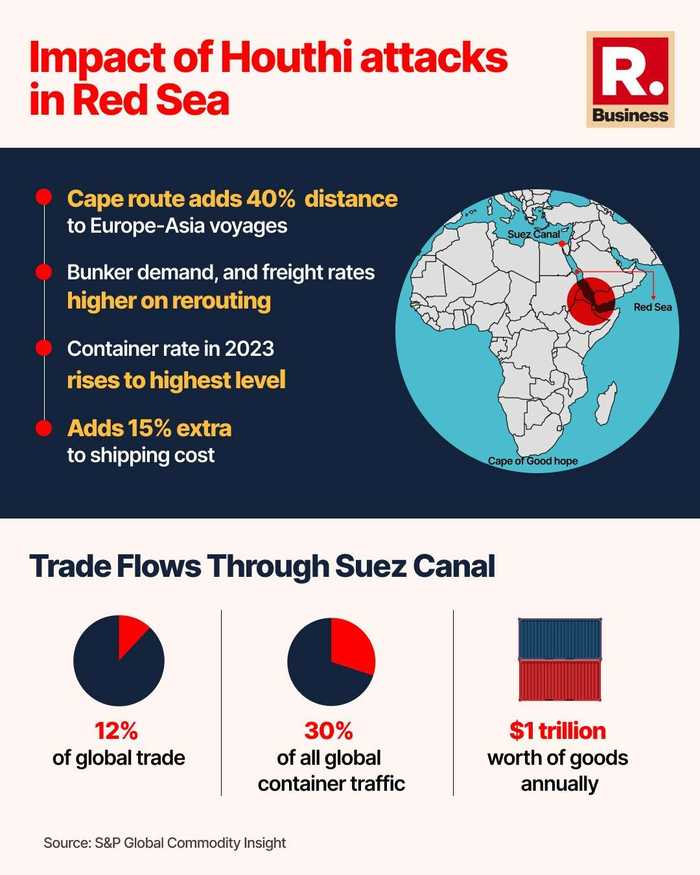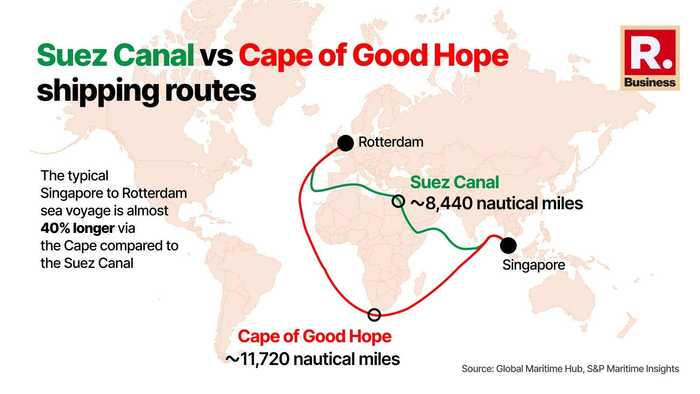Published 12:48 IST, January 1st 2024
Red flags from the Red Sea
It was in the middle of December 2023, when Iran-backed Houthis started attacking ships passing through the Bab al-Mandab strait at the end of the Red Sea.
- Economy News
- 7 min read
The world economy was already battling the ramifications of the pandemic and war-induced supply-chain disruption, all through 2022, and 2023, when another problem- Houthi’s attack on the Red Sea- knocked on the door at the end of 2023, which could be a potential disrupter for pandemic battered economies.
It was in the middle of December 2023, when Iran-backed Houthis started attacking ships passing through the Bab al-Mandab strait at the end of the Red Sea. The disruption in one of the most crucial trade routes in the world could derail global trade, spook economies, push up intractable inflation, leading to higher commodity prices, and lower profitability for the companies. In totality, this is a perfect recipe for disaster for trade in 2024, if not tamed well before this crisis hits hard.
“It's a very important route, as 40-45 per cent of India’s total trade to the European Union goes through this route, this route holds major importance in India’s trade route, our imports and exports both are heavily dependent on this route, be it oil import from Russia, we export pulses to Africa,” Ram Singh, Professor of Trade at Indian Institute of Foreign Trade told Republic Business.

Global trade artery
Red Sea, Suez Canal, and Bab-el-Mandeb Strait together form the artery of world trade, when they get clogged, a major heart attack follows. Bab-el-Mandeb Strait, a crucial shipping route connecting the Red Sea and the Mediterranean Sea to the Indian Ocean, is vital for 30 per cent of global container traffic. Suez Canal’s importance can be gauged by the fact that the waterway carried over 1 billion tonnes of cargo in 2019, representing four times the cargo carried through the Panama Canal.
“It is a major shock after the pandemic and Russia-Ukraine war, 30 per cent of Indian trade take place through this route, import of crude oil also happens through this route, agro-commodities are exported from India through this route, it has its ripple effect across the world,” Manu Chaudhary, Co-Chairman, Logistic Council, ASSOCHAM, told Republic Business.
The economy watchers are factoring in this ongoing crisis as a bump in taming inflation, derailing the global and Indian economic recovery. The ripples of the crisis are visible in the form of edgy crude oil, rising logistics costs, shortage of containers pushing up the container prices, soaring freight costs, delay in order delivery, and increase in transit time.
The disruption in the route has necessitated giant and leading shipping companies to go by the alternative route via Cape of Good Hope traversing an extra distance of around 10,000 km leading to higher freight charges and delays. Amid the troubled trade routes, the shipping companies have raised the freight charges by 30-40 per cent, posing a challenge for traders across the world.

EURONAV, the Belgian oil tanker firm said that it would avoid the Red Sea area until further notice. Similarly, global logistic firm C H Robinson also rerouted more than 25 vessels around the Cape of Good Hope over the past week, and that number would likely continue to grow.
MAERSK, the second largest shipping company in the world, also announced on December 31 that it is pausing all sailing through the Red Sea for 48 hours after Houthi militants attacked the container vessel Maersk Hangzhou with missiles.
“Global shipping companies like Maersk, MSN have imposed a peak season surcharge between $1500-1800, emergency recovery surcharge of $2,000, and freight cost has gone up almost by 30-50 per cent in the last few days,” Chaudhary of ASSOCHAM said.
One freight forwarder claiming anonymity said that the freight rates for some routes have gone above the pandemic levels.
Freight charges for Kolkata to Rotterdam in the Netherlands are currently floating around $4500, the prices shot up from $1850 a week ago to $4500 now, which is well above the freight charges of $3800 for the same route during the pandemic.
For Mumbai to Rotterdam, the freight charges went up from $1200 a week ago to $3500 now. It is not only the freight charges that are making traders jittery, but the increase in insurance premiums has also hit the traders hard.
“Since we export to the US and Europe, this ongoing crisis in the Red Sea is tossing up many challenges for us. Our consignments are being delivered late, almost 15-20 days late, waiting time for containers has also surged from 3-5 days to 8-10 days,” Rajendra Kumar Jalan, Vice-Chairman, Council for Leather Exports told Republic Business.
It's not only the rise in fright charges that has posed a formidable challenge for traders but insurance premiums have also gone up significantly. As per S&P Market Intelligence, currently, Long Range, or LR tankers, which carry up to 90,000 mt cargoes, command an additional $150,0000 security charge for each voyage when moving refined products from the Middle East and India to Africa.
Inflationary concern
The disruption in and around the Red Sea can have a huge impact on inflation. Around 12 per cent of global trade passes through the Suez Canal, representing 30 per cent of all global container traffic, and over $1 trillion worth of goods per annum.
In 2020, approximately 19,000 ships utilised the route. This represents 50 ships per day making the journey between Suez Port carrying between $3-9 billion worth of cargo.
“It's one of the significant routes through which energy, commodities, consumer goods, and components from Asia and the Middle East to Europe are exported and imported. It enables the transfer of an estimated 7-10 per cent of the world’s oil and 8 per cent of liquefied natural gas,” Singh of IIFT said.
As per data from the Suez Canal Authority, approximately one million barrels of oil traverse the Suez Canal daily and in 2019, 53.5 million tonnes of ores and metals and 35.4 million tonnes of coal traveled the length of the canal, this shows the importance of the route.
“Our cheap Ural oil import from Russia happens through this route, from Black Sea to Bosporus, Aegean Sea and finally through the port of Alexandria to Suez Canal, almost 33,000 vessels in a year go through this route which is very important,” Professor Singh said.
The rise in freight charges, container shortages, and this supply chain disruption, will lead to price rises across the board leading to broad-based inflationary pressure, driven largely by higher oil prices, which will in turn have a cascading impact on the economy.
According to freight analytics firm, Vortexa, the Suez Canal is the quickest sea route between Asia and Europe and is particularly important in the transportation of oil and liquefied natural gas (LNG). “About nine million barrels of oil per day were shipped through the Suez Canal in the first half of 2023,” it said.
Singh believes that this disruption will have direct and indirect impacts. This will have an impact on energy supply, and commodity prices. “ The biggest impact it can have is on energy prices, which will have a cascading effect on the economy, as the price of oil goes up, inflation also goes up,” Singh summed up.
On the other hand, Suman Chaudhary, Economist and Head of Research, Acuite Ratings, sees only the short-term impact in the near -term. “I think there is the impact which might mean shipping line transportation costs for some of the imported goods and exports also, margins may have an impact, not sure whether this will have a long-term impact. The issues are being addressed on priority,” Chowdhury said. The impact of the Red Sea on crude oil is not significant in India, Chowdhury added.
“Crude oil impact is not significant, the majority of oil comes from Iraq, UAE, and Saudi Arabia, all these are not affected by the Red Sea, they all come through the Persian Gulf, only the Russian part will be impacted, and that will have a short term impact on exports and imports,” Chowdhury said.
Updated 17:35 IST, January 28th 2024